
|
|
|
|
|
Jack the Lizard is on YouTube |
Ocean Has the Great Oxygen Producer
|
The surface of the Earth is mostly covered by the ocean. Unfortunately it is not easy to observe many part of it because obviously, the ocean has vast space, depth, and complicated structure such as coral reefs and trenches. On the other hand many scientists are fascinated by its massive size and undiscovered territories and willing to explore, because the ocean is abundant in lives as well as mountains, forests and prairies on the ground. It is absolutely no doubt that the studies have been telling us that the ocean has very rich, delicate and fragile environments to contain those lives. Humans need oxygen to live and we know that the oxygen is produced by plants. Therefore we tend to think that at first forest on the ground should be protected. However believe or not, at least the half of the oxygen in the air is coming from phytoplankton and sea plants in the ocean. In a mean time, much carbon dioxide is absorbed by them. Without their help the temperature of the air will rise rapidly by carbon dioxide. 
Sea urchins and the Copper Rockfish on the ocean floor
|
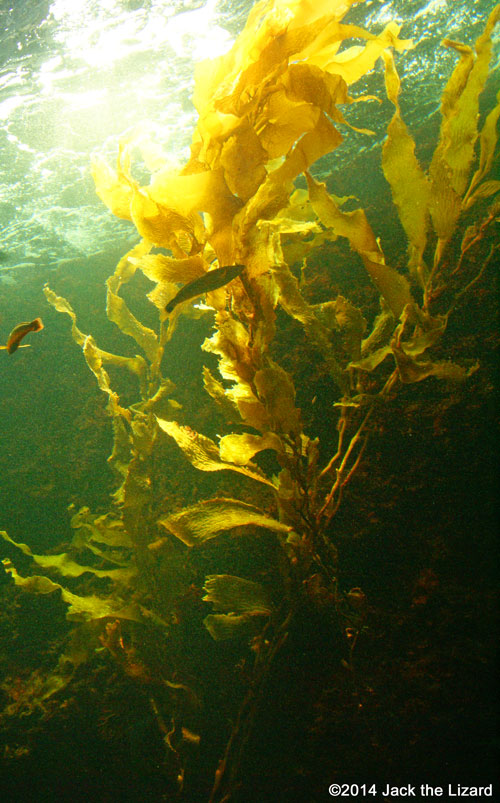
Giant Kelp
|
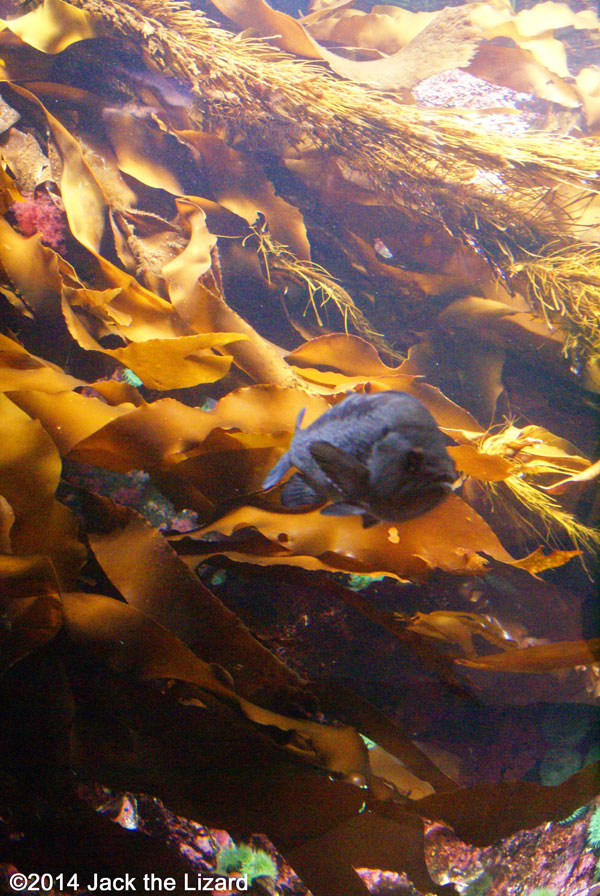
|
For example giant kelp which is found in the coast of California absorbs great mounts of carbon dioxide and emits oxygen into the air. Giant Kelp flourishes fast into the average height of about 50 meters. The kelp is able to forms broad forest on the sea floor because it has bladder filled with gas, which helps the kelp stand straight toward the ocean surface. The kelp forest is like the amazon forest in the water. It provides a great shelter and hunting fields for many fish species and other sea animals. Also the kelp itself is foraged by some creature such as sea urchins. By the way too many sea urchins are no good for the kelp forest because sea urchins could wipe it out. Thanks to sea otters who love to eat sea urchins protect the kelp forest. They may be small animals but certainly have great roles in the ocean. |
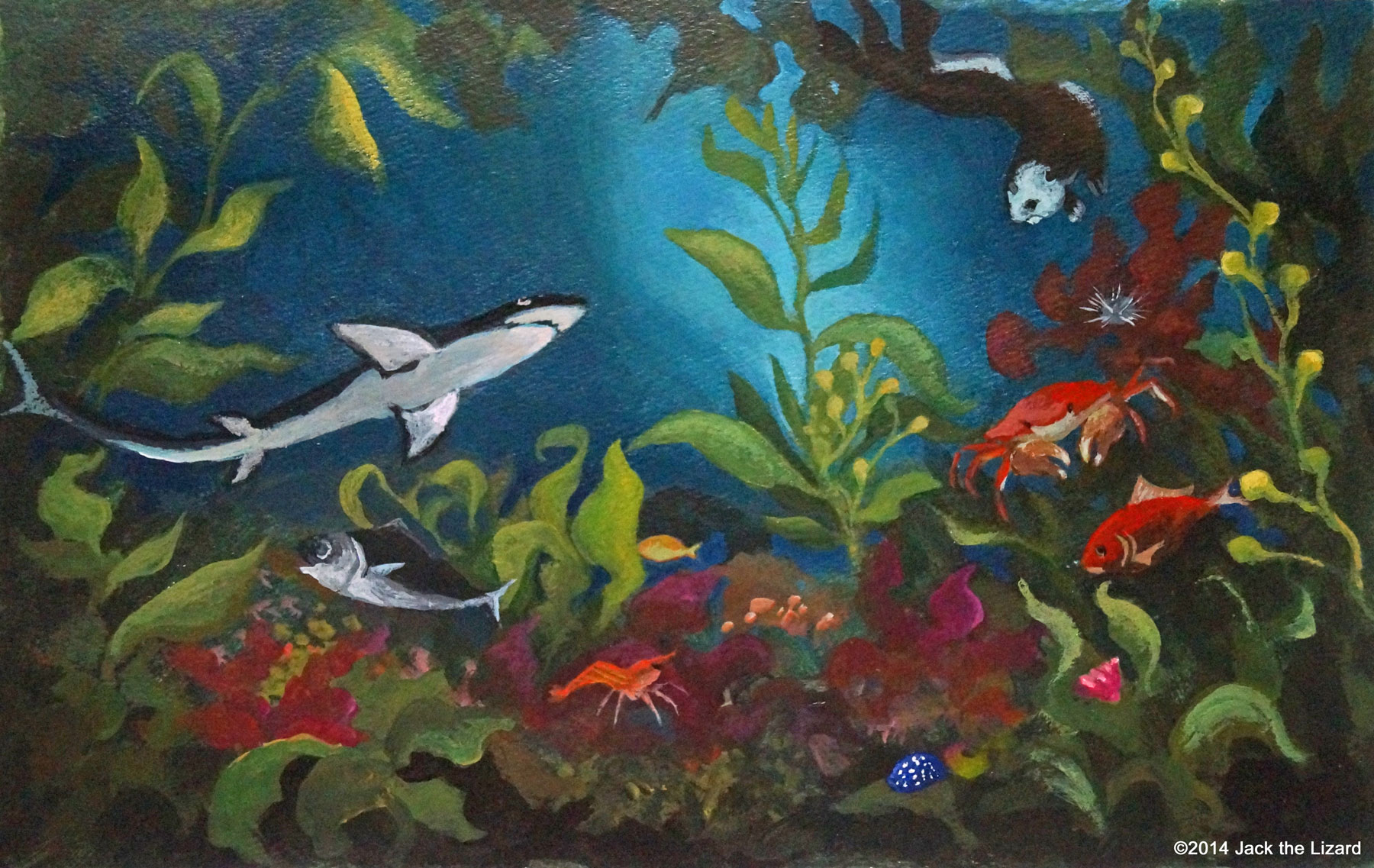
Countless phytoplankton and invertebrates gather around kelp forest. Also vertebrates such as fish, seals and birds depend on kelp forest.
|
Ocean has dynamic Faces
|
The ocean covers most of the earth surface. Naturally the ocean create climatic phenomenon in various ways such as rainfall and temperature. Nearly half of the human population live in the place within 150 km from the seashore. As human population increases rapidly, the ocean also affects lives of people who live far from the sea through climatic change. Besides human use the ocean diverse ways such as food source and the transportation. Therefore human life deeply entwine with the ocean. The ecosystems of the ocean are intricate and fragile. Especially the point where the ocean and the land meet, the coastline has distinct faces. Those ecosystems of the coastline are composed of rivers, water current, temperature, and other factors. Animals are also important player to sustain them. Let’s take a closer look at how each ecosystem of the ocean works.
|
The Home of Millions of Lives - Beaches -
|
At a sandy beach we see nothing but sand, no animals or plants at all. Actually millions of lives are found underneath of your feet when you stand on a wet sandy beach. They are just too small to be observed. Sandy beach is a home of more than half of the major animal groups (phyla). As matter of fact some sandy beaches teem with animals have more bio diversity than Amazon rainforests. 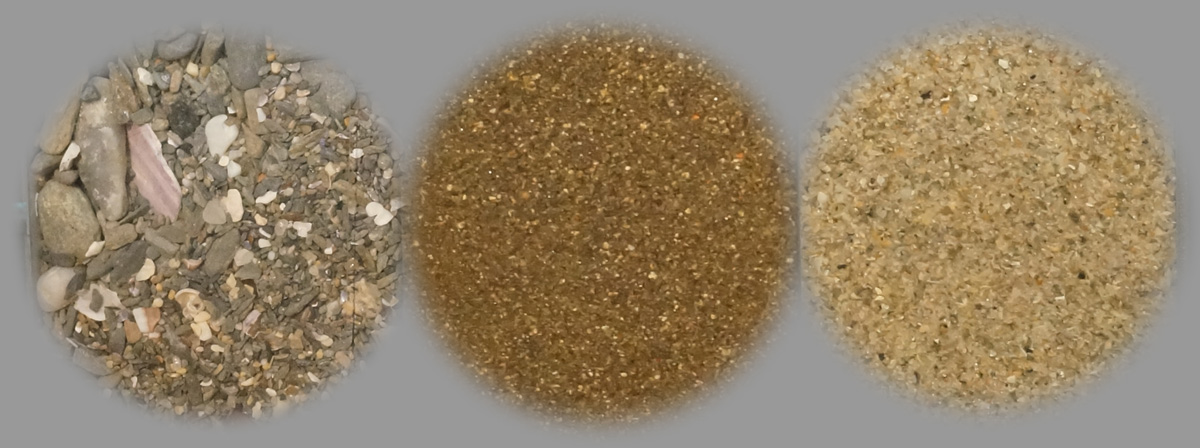
Different kinds of sandy beaches are formed depend on the shape of the coast line, currents, waves, winds, and so on. Sand of beach is also varied. Larger grains tend to remain where the waves are strong enough to wash smaller grains away. On the other hand since the beach behind calm sea has small and smooth grains, you are able to walk on comfortably. Then the environment of a sandy beach change from time to time, it is not easy for animals to live in, so the animals have to have some strategies to live without being washed away. |
|

Bay of Fundy, Nova Scotia, Canada
The unique topography of the bay causes the highest tides of the world. The sand grains are larger.
|
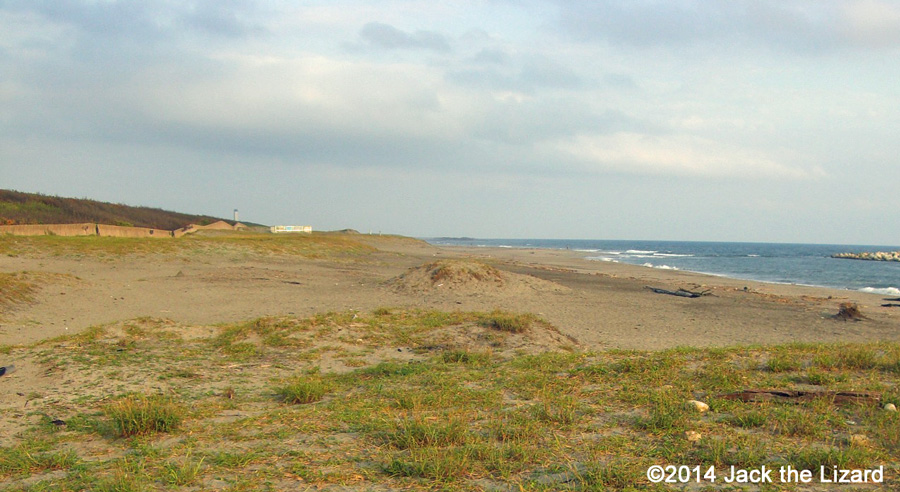
Enshu-nada Beach, Hamamatsu, Shizuoka pref., Japan
Facing to the Pacific Ocean, the long beach has smaller grains of sand.
|
|
Here are some examples; 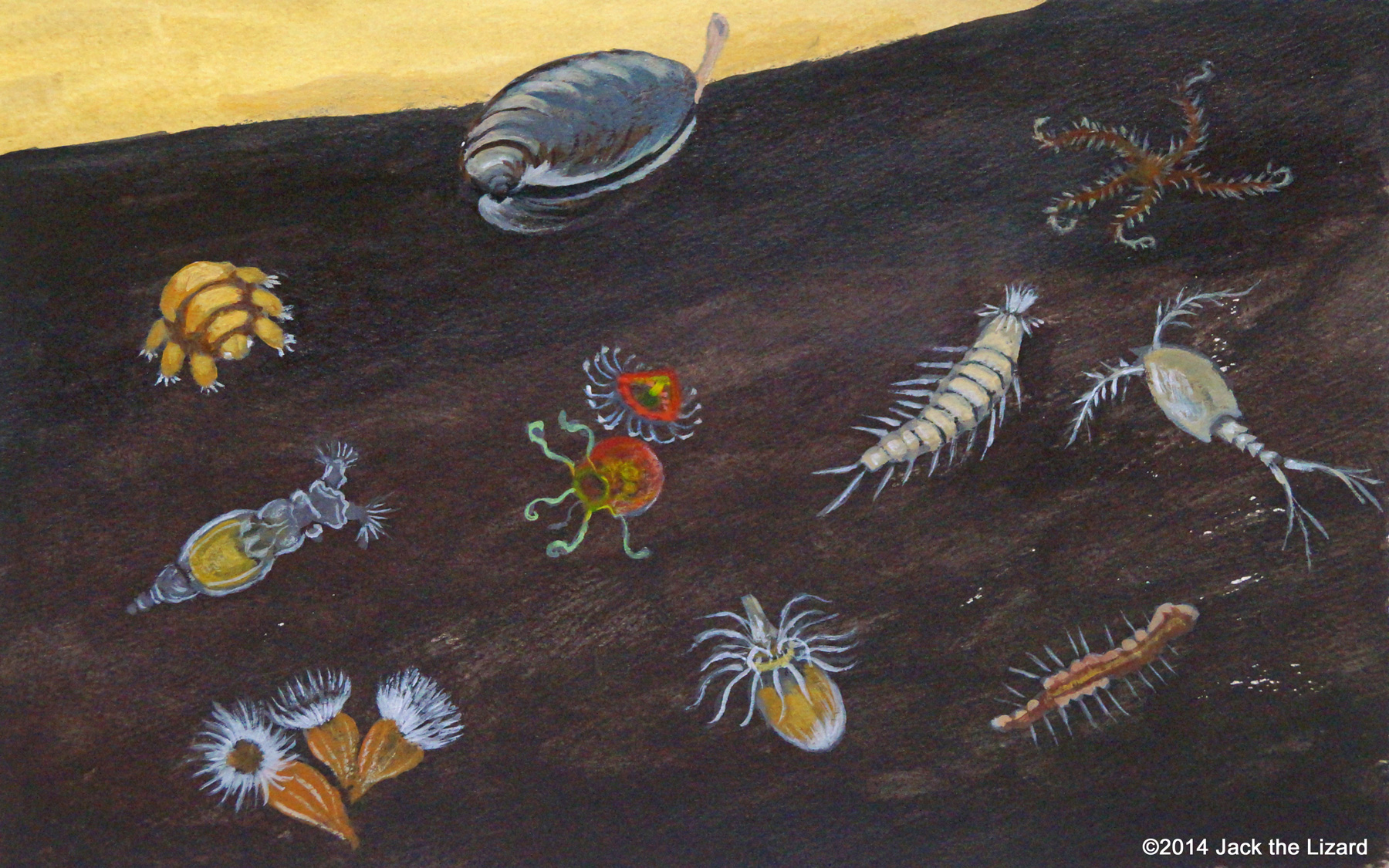
The size of them are between about 0.05 to 1.7 mm.
From upper left, Tardigrada, macrotrachela, ectoprocta, cnidaria, loricifera, aeolosoma, kinorhyncha, arthropoda. |
|
River Mouth Dweller - Estuary environment -
|
Estuary is where the river water flows into the ocean. The river is widening toward the ocean and streaming calmly. Here the fresh water meets salty seawater and get mixed. The salinity of water keeps changing depend on high or low tide and rainfall. The salinity of the estuary is lower when the tide in low river water flows into the ocean, and it is higher during the high tide because seawater flows into the estuary. Also salinity varies according to the topography around estuary or depth of river water. Since the salinity of estuary is constantly changing, animals living in estuary face great difficulty. The cells of body get dehydrated in the water with high salinity. On the other hand they absorb too much water in the low salinity. Therefore animals must have some strategies to live in estuary. For instance animals with great mobility, such as fish are able to move simply to the zone with proper salinity level. Whereas one is not able to move fast, such as clams bury themselves into the mud because salinity level is relatively stable in there. |
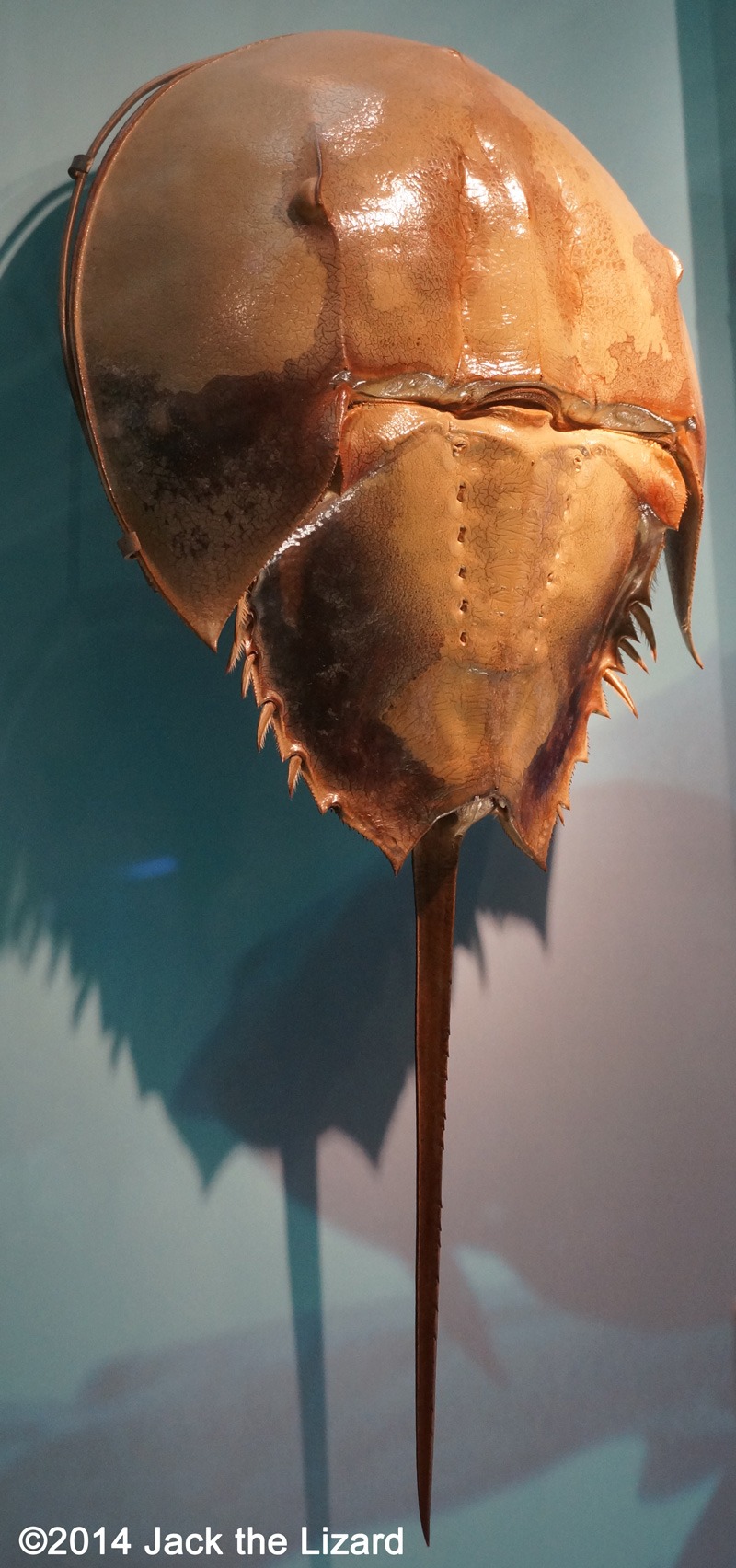
Horseshoe Crab
(Display by Smithonian Institution National Museum of Natural History) |
|
|
What will happen to animals cannot move at all, such as barnacles? They just keep comfortable water inside and shut their shell tightly. Some animals such as soft shell clams and horseshoe crabs are able to match the salinity of their body with surrounding water. There are animals such as blue crabs, fiddler crabs, and winter flounder have no problem with change of salinity. |

Animals and plants in Estuaries
(Display by Smithonian Institution National Museum of Natural History) |
|

Estuaries Environment
|
||
Mangrove Kingdom
|
Mangrove forests are found in coast of the tropics and subtropics regions. In mangrove forest there are several species of trees which are able to tolerate salt water and tidal condition. During the high tide roots of mangroves submerged in the saltwater, in addition to the soil of mangrove forest increases the percentage of salt within because sun light evaporates sea water in the period of low tide. Only mangroves, approximately 110 species, are able to adapt to this environment. |
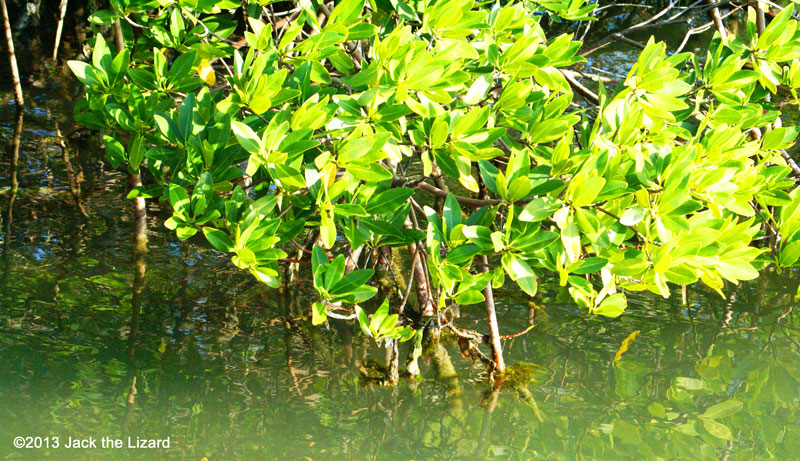
|
|
Broadly spread roots of mangrove grab mud came from land and protect land from erosion and tsunamis. Mangroves also provide home for many species of plants and animals. The complex of roots’ system provides a shelter for young fish from predator. Roots also have several filter feeders such as barnacles, sponges and oysters. While shrimps and mud lobsters are able to hind themselves in the mud, mangrove crabs supply nutrients to bottom feeder by decomposing leaves of mangrove. Meanwhile the sediment of mangrove absorbs heavy metals of which contamination causes serious problems in the sea. |
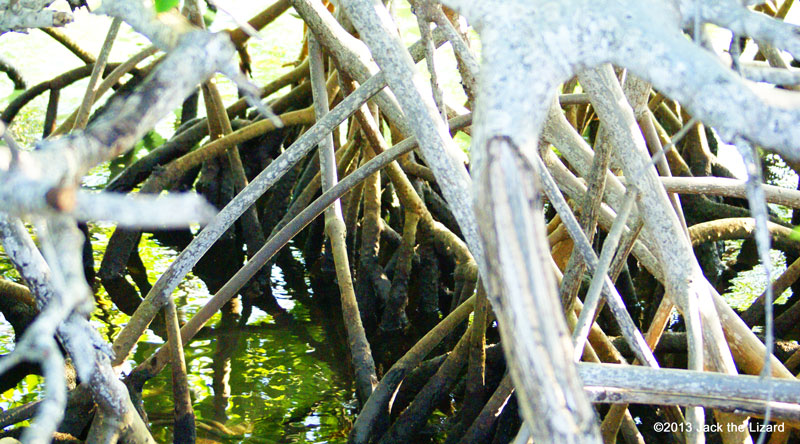
|

Scylla serrata or mud crabs are living in mangrove forests of Africa, Asia and Oceania.
Royal spoonbills are found in Australia, New Zealand, Papua New Guinea, and Indonesia.
Mangroves stick aerial roots out of mud to breath.
|

|
Despite the importance of mangrove forests for global ecosystem, all most half of mangrove forests are already disappeared. Shrimp farming is important industries for some countries such as Vietnam and Philippine. In order to make ideal farm the area of mangrove forests were destroyed. While some countries such as Thailand do realize that the serves mangrove forests provide are enormous and prohibit the development in the mangrove forests or set the limits. 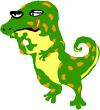
|
Grasses Living in Sea - Seagrass Meadow -
|
Seagrasses are flowerBrackishing plants that inhabit shallow marine and estuarine waters. Although some species such as common eel grass spreads broad region and many species are found in the worldwide, the number is not clear. It may exist between 48 to 70 species. Most species reproduce themselves by pollination in completely underwater environment. The meadow formed by seagrasses provides food and shelter for many species of animals and other environmental function. For instance the leaves keep current speed down and the roots stabilize sand. They also absorb carbon dioxide and emit enormous oxygen into the air. Usually water around seagrass meadow is clear because seagrass trap particles and excessive nutrients which cause the deterioration of water condition. The leaves are fed by many species such as turtles, manatees, dugongs, fish, crabs, and sea birds. Whereas the importance of seagrass meadows is recognized gradually, seagrasses are disappearing from coastal line around the world. Multiple reasons cause the decrement of seagrass meadows. Taking the sand bottom for human use is the one and too much nutrients are supplied from land is another. Seagrasses need sunlight for photosynthesis, but surpass of nutrients increase algae which prevent sunlight to penetrate water. Large predator fish control the number of seagrass grazers such as crabs and gastropods, but over fishing is also helping the increase of seagrass grazer and inevitably the healthy seagrasses meadows will be lost. However it is possible to recover seagrass meadows by implanting in the sea floor. Local of Seto Inland Sea region in Japan have been restoring seagrass meadows for many years. Although it takes time and effort, now restored seagrass meadows attract many species of fish and animals. 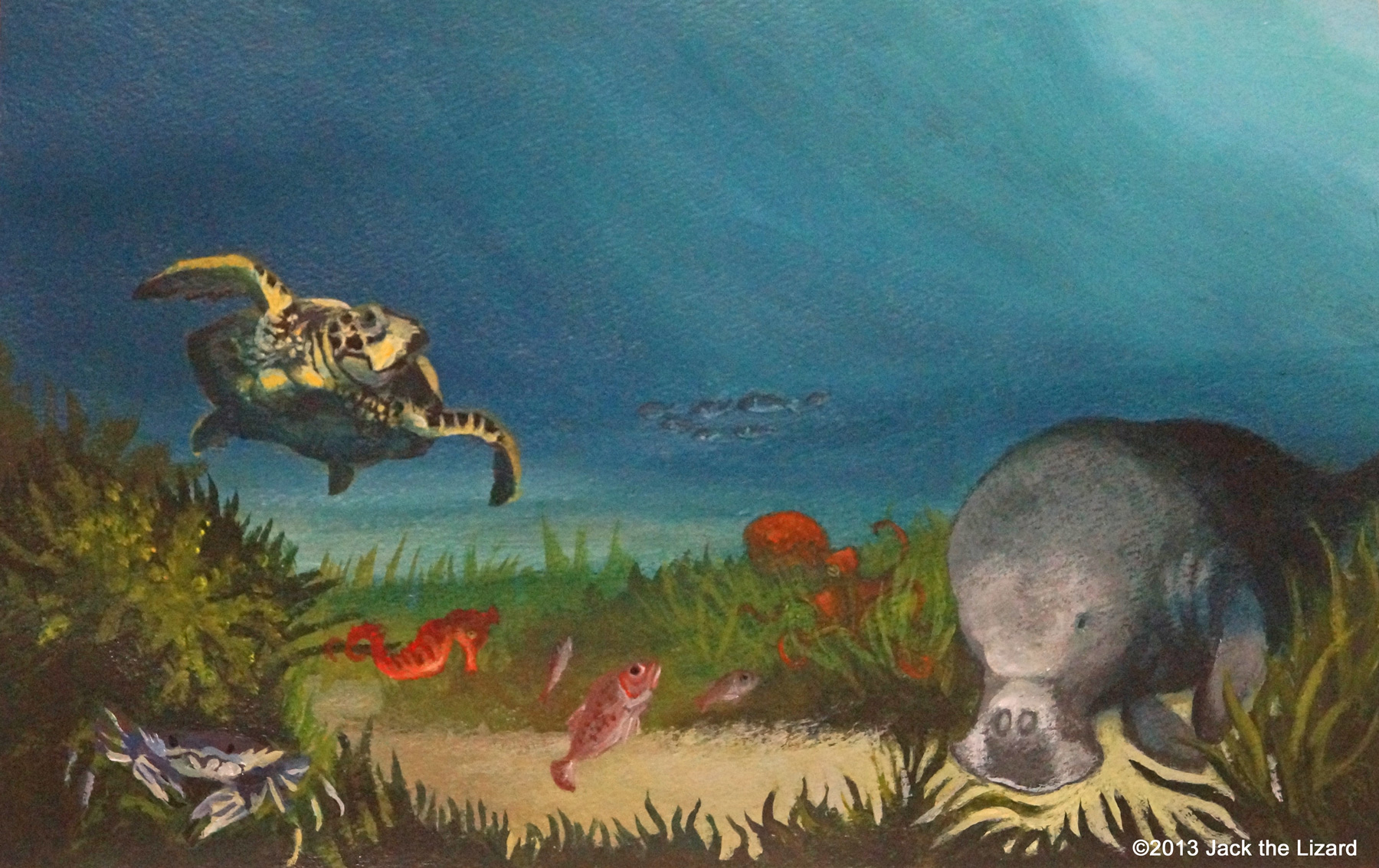
Seagrass Meadow
|
Brackish Water Animals - Where fresh water meets salt water -
|
Brackish water is water including salt, but the percentage of salt is lower than sea water. This kind of water often occurs in estuaries in which fresh water meets sea water. Mangrove swamp also holds brackish water and unique ecological system within. Some seas and lakes such as The Baltic Sea and The Caspian Sea contain brackish water as well. It is not easy for animals to adapt and live in brackish water, but some of them definitely need brackish water to complete their life cycle. Salmons back from the oceans adjust their body to fresh water environment in brackish water area. Then they ascend rivers to lay their eggs. Eels on the other hand enter brackish water before they start their life in sea. Either way they need brackish water. Many fish species spend their juvenile period in brackish water because there are many nutrition and few predator fish are able to adapt themselves to this extreme environment. Human deliberately create brackish water pools to use as fresh water prawn or salmon farming. However artificial brackish water often causes environmental disruption, because brackish water is toxic for many species of plants and animals. 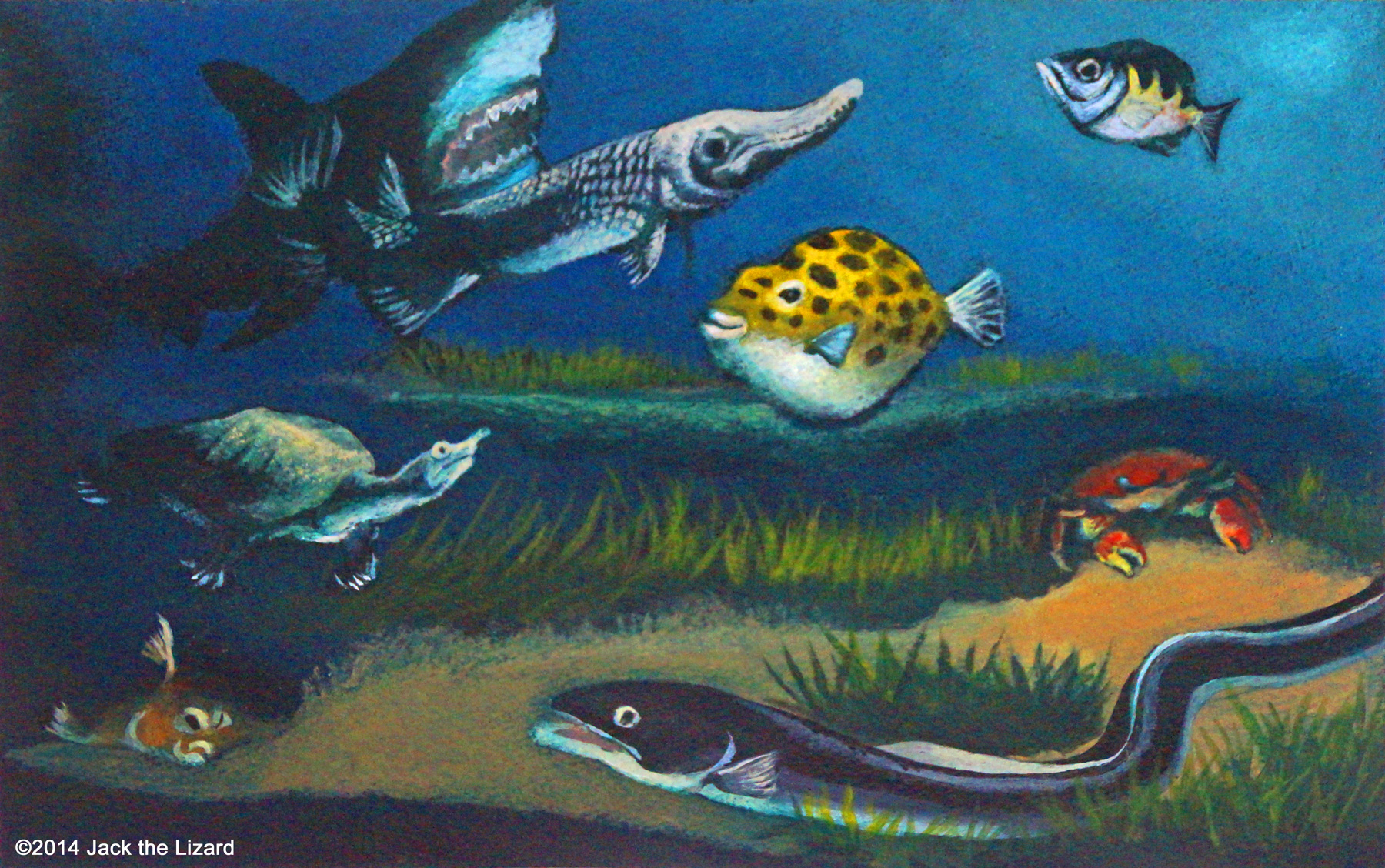
Where fresh water meets salt water
|
Spaces Life Occur in Ocean
|
By and large marine animals have four different life styles. Animals that spend most of their time at sea surface are called Neuston. On the other hand Nekton is an animal that live in mostly under the water and are able to swim actively. Also Plankton stays in under the water, but does not have ability to swim or have too little to swim against water current. Benthos is the group of animals inhabits mainly sea floor. The size and kind are not matter in these categories. So Nekton includes sea birds, whales, tuna, and some squids. Nomura’s jellyfish is gigantic plankton, growing up to 6.6ft (2m). Some bacteria and drifting algae compose Neuston. Variety of animals stay on the seabed, so benthos is made up of mollusks, crustaceans, fish, and sea grasses. |
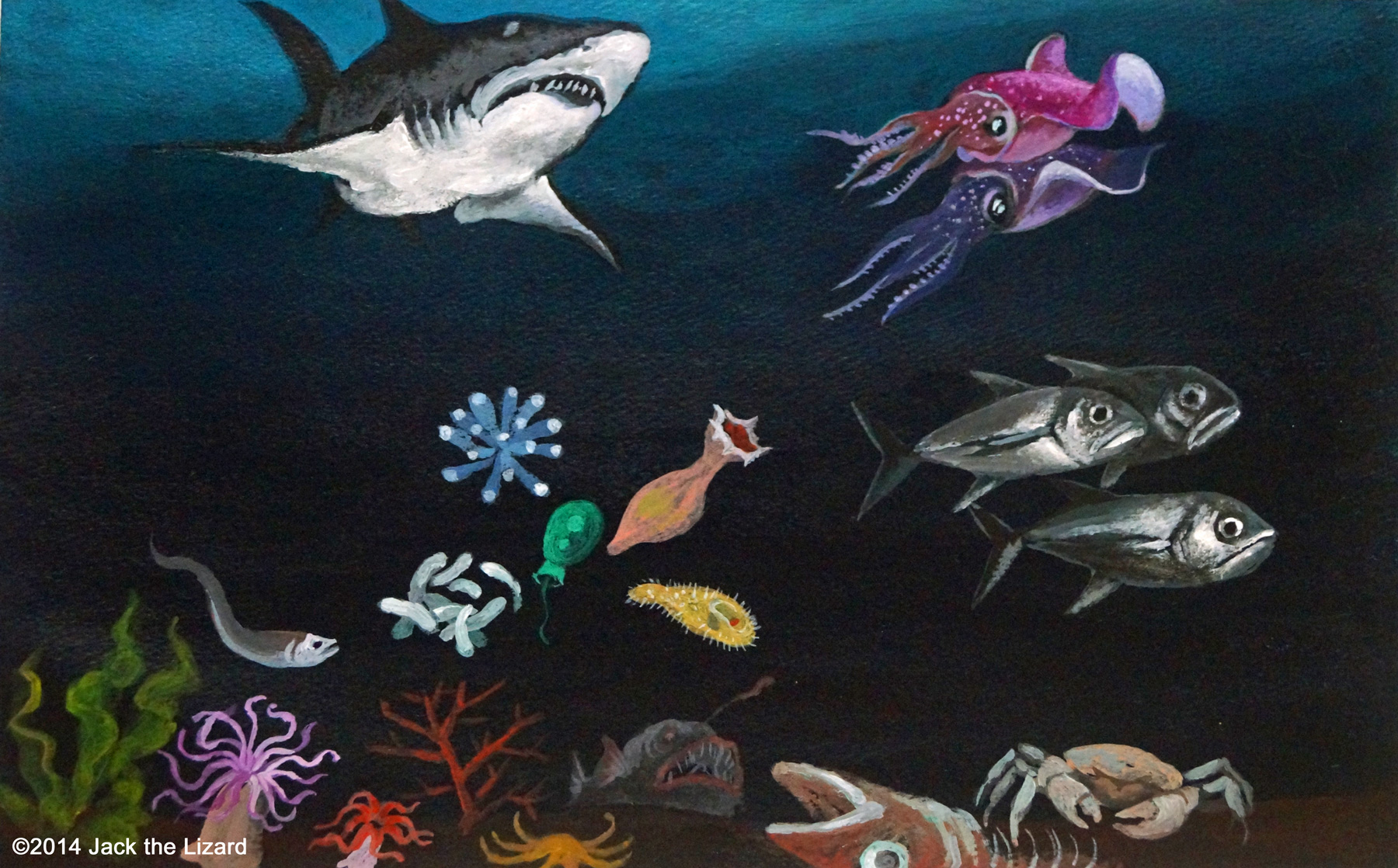
|
The Loop of lifeOne important oceanic ecosystem starts from sunlight. First and foremost Phytoplankton makes energy through photosynthesis by using sunlight. Sunlight also provides iron which is rare in the ocean and essential for phytoplankton to survive. Then Zooplankton eats phytoplankton, and those tiny planktons are consumed by fish and other marine organism. However there is another significant activity, called “Microbial Loop” sustains the ecosystem in the ocean. Bacteria at workAlthough a supply of nutrients is limited in open sea and not much sunlight reach deep water zone, still many marine animals live in those environments because of microbial loop. Bacteria that are single—cell organisms without nuclei and virus are major players in microbial loop. In the ocean water there are full of dead organisms and excretion. These organic matters are called detritus. Bacteria eat detritus and produce water and carbon dioxide. Phytoplankton use carbon dioxide for photosynthesis. Some bacteria decompose hard organic substance such as crab shells and some are even able to break up plastic. After the decomposition those organic matters are available for other animals. Bacteria are free living animal and able to catch free meals falling down from above. Even in the water scarce of oxygen anaerobic (no oxygen required) bacteria thrive comfortably. In addition if condition allowed they are able to multiple themselves rapidly. But their numbers are restrained, because they are consumed by planktons such as flagellate and ciliate. Viruses also kill bacteria and the body of bacteria becomes food for other bacteria and life form. Virus is the source of driveViruses have another role to let microbial loop work smoothly. While viruses are harmful for ocean life, they are also food provider to other animals, because the body of planktons killed by viruses becomes food for bacteria and other life form. It seems that viruses do not have natural enemy, but actually they are not able to survive without infecting other living organism. In this way viruses maintain the very foundation of marine ecosystem. |
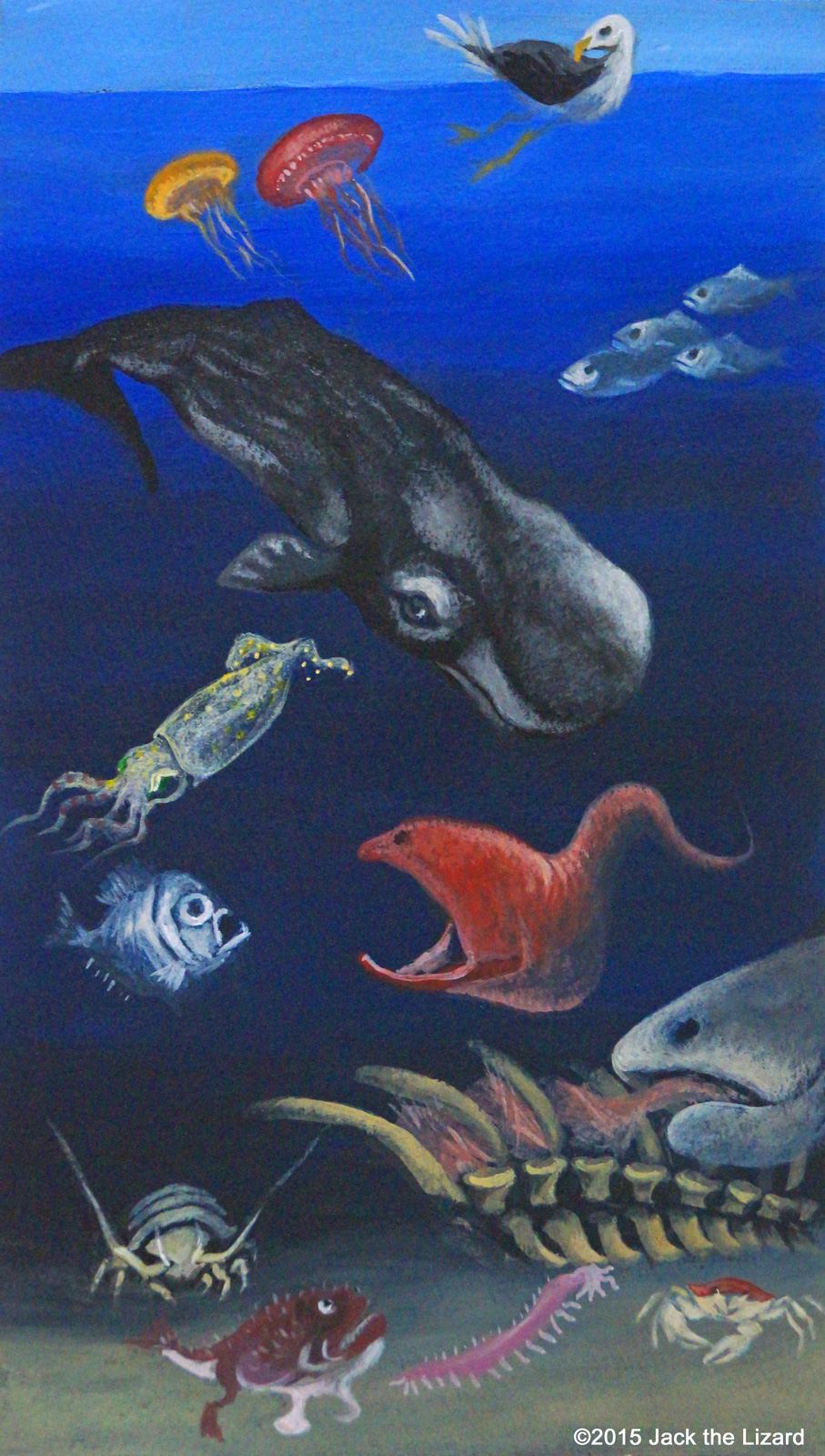
|